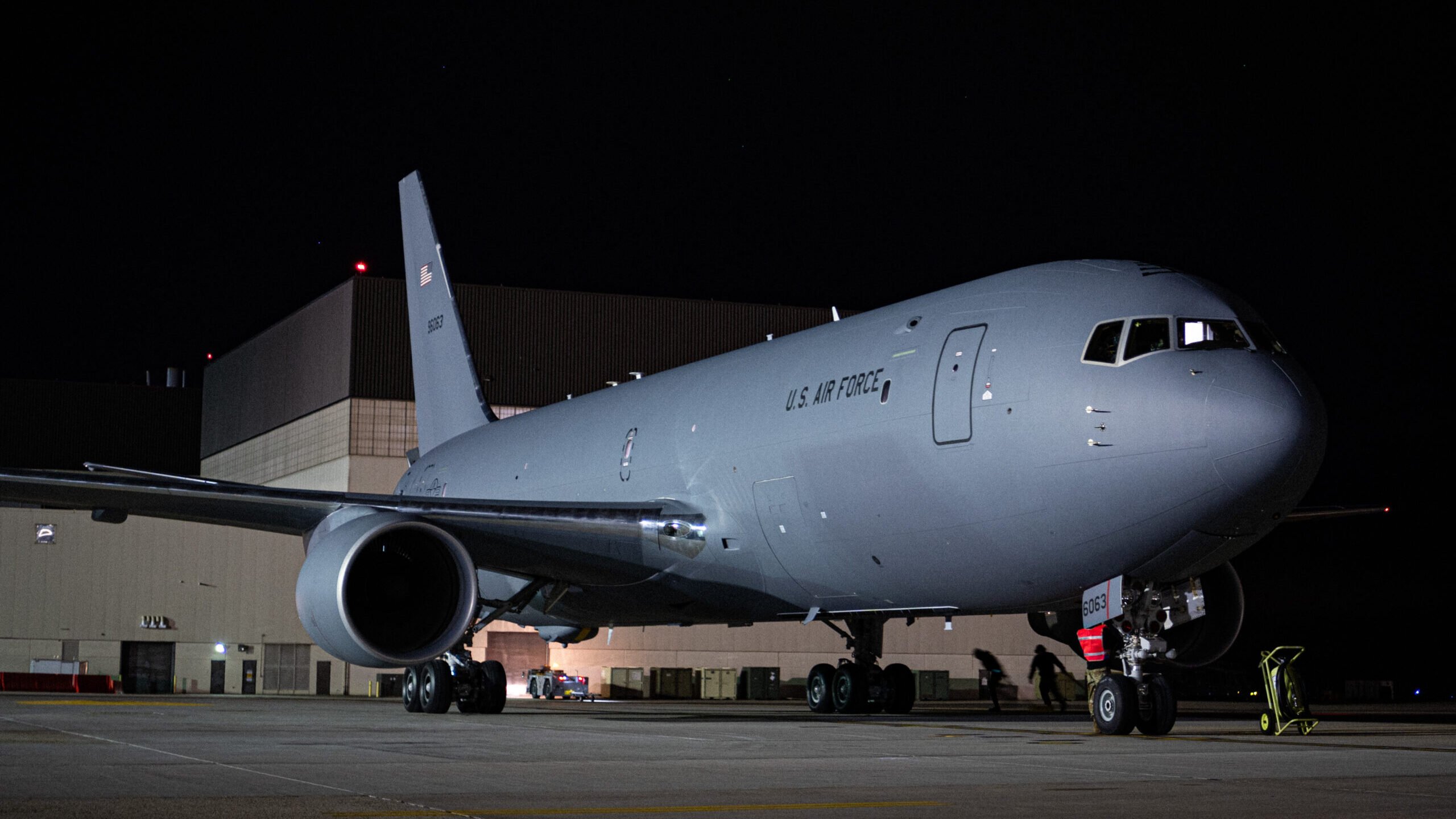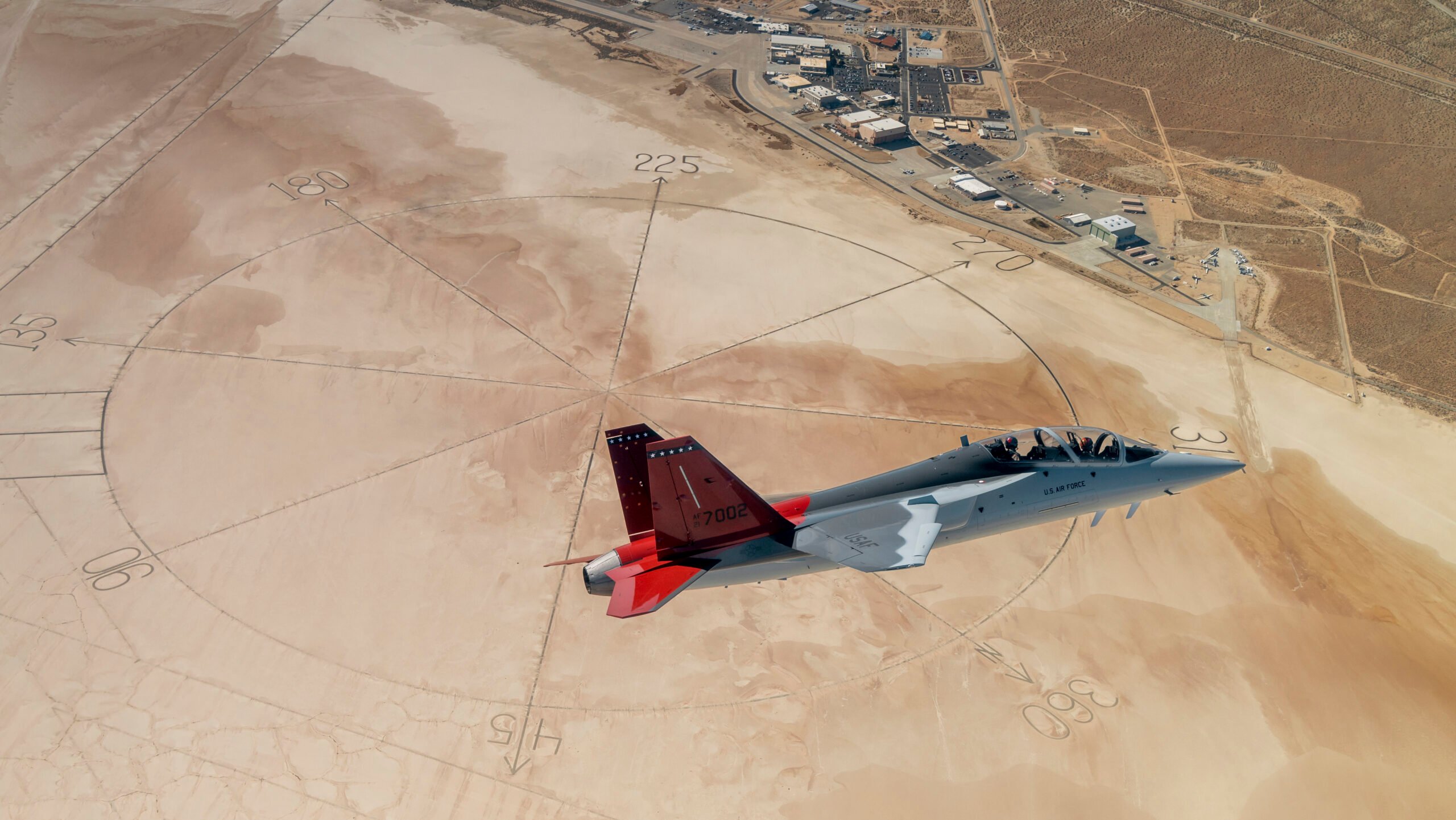
A KC-46A Pegasus arrives at Joint Base McGuire-Dix-Lakehurst, N.J., Dec. 21, 2021. (US Air Force/Airman 1st Class Joseph Morales)
WASHINGTON — For years the fixed-price deals that Boeing signed for programs like the KC-46A Pegasus air refueling tanker and T-7A Red Hawk trainer have been headaches for the aerospace giant amid billions in losses stemming from delays, supply chain constraints and developmental woes. And now, according to the Air Force’s acquisition czar, more delays for both efforts could be coming.
Testifying before the House Armed Services Seapower and Projection Forces subcommittee on Tuesday, Andrew Hunter said that an upgrade for the KC-46A’s long-troubled vision system would likely arrive in 2026, slipping past an already 19-month delayed projected fielding date of October 2025. After the hearing, he separately told reporters that the service would “probably” approve production of the T-7A trainer later than previously expected.
“There is some schedule pressure there,” Hunter told lawmakers about fielding a new vision system for the KC-46A, dubbed RVS 2.0. “And depending on completion of the Federal Aviation Administration (FAA) airworthiness certification process, I cannot guarantee you that we would be in a position to field in ‘25. It may be ‘26. And that is actually likely — I think it probably will field in ‘26.”
Following the hearing, Hunter explained to reporters a potential Pegasus delay is tied to the FAA certification process, reasoning that when RVS 2.0 is integrated, “you have to make sure that it doesn’t affect something else somewhere else on the airplane. So it makes the airworthiness process more complex than it might appear because it’s essentially about more than just the cameras that you’re dealing with.”
Hunter added he was “confident” that the Air Force and Boeing “have the right design” and that the team “will get through the full airworthiness process in the near future.”
RELATED: Inside Boeing’s plans to fix its troubled KC-46A tanker
Boeing so far has reported over $7 billion in losses on the Pegasus program due to its fixed-price structure, though it’s not clear if more losses could be associated with an additional delay for RVS 2.0. Boeing deferred questions to the Air Force, but the company has previously touted the capabilities of the new vision system as providing marked improvements over the baseline version.
Despite the vision system problems, the aircraft has been cleared for combat deployment and can refuel most of the US fleet except the A-10 due to a separate issue with an actuator on the tanker’s boom that is expected to be resolved by FY26. Hunter suggested last year that the service was leaning toward buying more of the tankers as part of a new strategy to continue recapitalization of the service’s aging KC-135 refuelers, though a service official would later say that an acquisition strategy had not yet been decided.
Europe’s Airbus has positioned itself as an alternative should the Air Force decide on a competition, after its partner Lockheed Martin announced it was bowing out.
In his testimony this week Hunter said that autonomous capabilities could be incorporated into the future of aerial refueling, but he told reporters that it would not be a requirement for the next tranche of tanker procurement.
“I think that would be something we would look at as an independent effort and then potentially field in the future,” he said of autonomous refueling.
In written testimony on Tuesday [PDF], Hunter additionally said the service would expand its current contract with Boeing slightly, adding four KC-46As for a total program of record of 183.

APT-2, the first T-7A Red Hawk for the USAF, flies over Edwards Air Force Base, Calif. (Air Force photo by Bryce Bennett)
T-7A ‘A Little Later Than We Expected’
Meanwhile, budget documents confirmed the Air Force’s decision to halve the fiscal 2025 procurement of T-7A Red Hawk trainer aircraft, meant to replace the aging T-38 Talon, from 14 to seven, and indicate delays for the program are at hand as well.
That program was rebaselined last year to reflect a delay of over two years. A subsequent watchdog report found that issues with the jet’s flight control software and escape system continued to pose risks to the already delayed schedule, particularly as the jet moved to enter flight testing where the Air Force could discover new flight control deficiencies.
RELATED: Air Force claims ‘fantastic’ relationship with Boeing on T-7A after scathing GAO report
Now, it appears the trainer’s schedule could slide a bit further still. According to FY25 budget documents released by the service Monday evening, a Milestone C decision — or the point when the service officially approves a program to enter into production — is projected for May 2025. Previously, officials planned Milestone C for February 2025, though the program has allocated a full year of schedule margin for the decision.
To help mitigate delays, Boeing began buying long-lead parts to hit the ground running for an eventual production decision. That approach required a special agreement between the Air Force, Boeing and the Defense Contract Management Agency to supervise early production, which the service told Breaking Defense last year had been reached.
Additionally, as Aviation Week previously noted, budget documents further suggest the jet’s initial operational capability could be delayed by a year, from the second quarter of FY27 to Q2 FY28. Boeing so far has reported about $1.3 billion in losses on the Red Hawk program, and it’s not clear if new delays could result in more charges. Like with the KC-46, the company deferred questions about the T-7A to the Air Force, which did not immediately respond to a request for comment.
Speaking to reporters after Tuesday’s hearing, Hunter explained that a decision to halve the buy of the T-7A in FY25 was mostly the result of topline fiscal pressures. Still, he said the lot size of seven Red Hawks “is a good place to start” for the service.
He said delays in the beginning the flight test program could translate to the trainer being approved for production later than anticipated. The service’s first T-7A touched down at Edwards Air Force Base in November.
“We entered the flight test program a little later than we expected, so we’ll probably start production a little later than we expected,” Hunter said. “Right now, the flight test program is going relatively well. If we don’t discover something unexpected, I do think we will get into production in fiscal year ‘25.”
Asked if the February 2025 Milestone C date is at risk, he replied “TBD on when we do Milestone C. It’s event-driven. We’ll have to see how the test program carries out.”






















